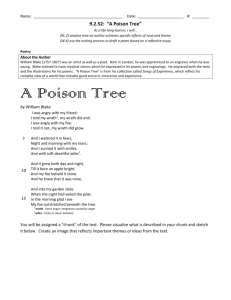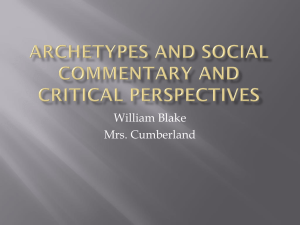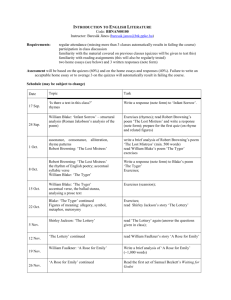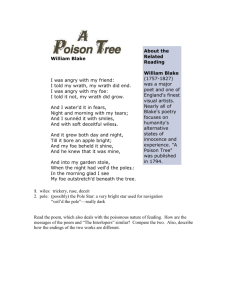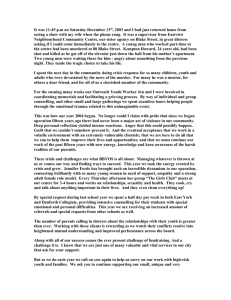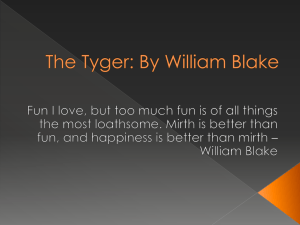Literary Criticism: “The Tyger” 1
advertisement
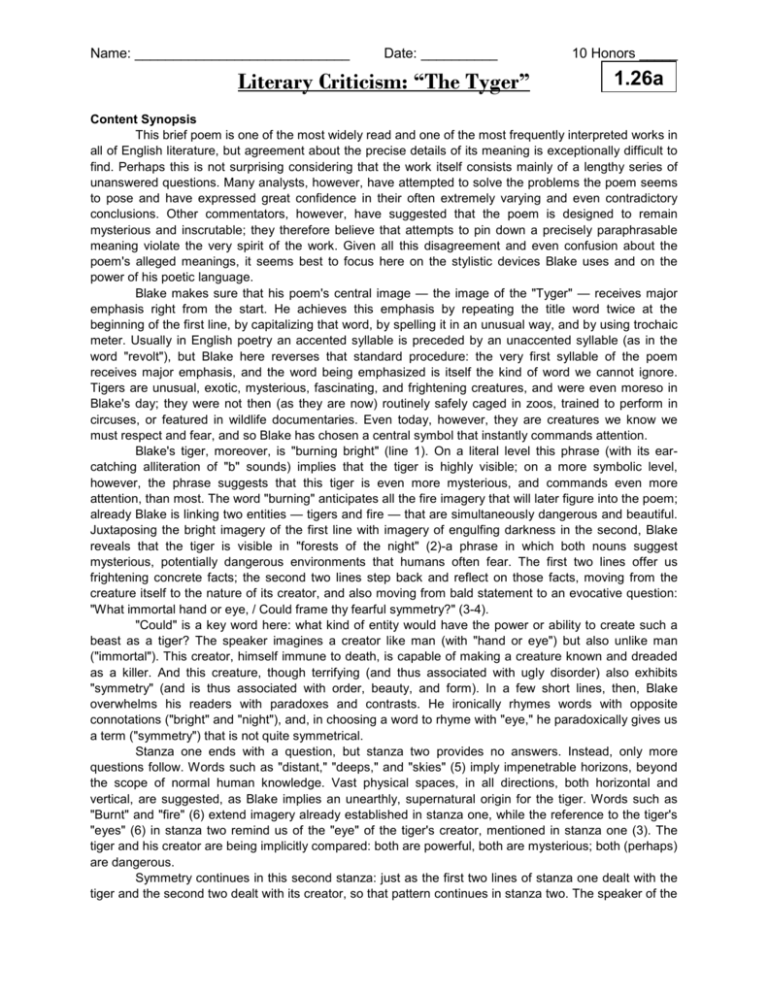
Name: ____________________________ Date: __________ Literary Criticism: “The Tyger” 10 Honors _____ 1.26a Content Synopsis This brief poem is one of the most widely read and one of the most frequently interpreted works in all of English literature, but agreement about the precise details of its meaning is exceptionally difficult to find. Perhaps this is not surprising considering that the work itself consists mainly of a lengthy series of unanswered questions. Many analysts, however, have attempted to solve the problems the poem seems to pose and have expressed great confidence in their often extremely varying and even contradictory conclusions. Other commentators, however, have suggested that the poem is designed to remain mysterious and inscrutable; they therefore believe that attempts to pin down a precisely paraphrasable meaning violate the very spirit of the work. Given all this disagreement and even confusion about the poem's alleged meanings, it seems best to focus here on the stylistic devices Blake uses and on the power of his poetic language. Blake makes sure that his poem's central image — the image of the "Tyger" — receives major emphasis right from the start. He achieves this emphasis by repeating the title word twice at the beginning of the first line, by capitalizing that word, by spelling it in an unusual way, and by using trochaic meter. Usually in English poetry an accented syllable is preceded by an unaccented syllable (as in the word "revolt"), but Blake here reverses that standard procedure: the very first syllable of the poem receives major emphasis, and the word being emphasized is itself the kind of word we cannot ignore. Tigers are unusual, exotic, mysterious, fascinating, and frightening creatures, and were even moreso in Blake's day; they were not then (as they are now) routinely safely caged in zoos, trained to perform in circuses, or featured in wildlife documentaries. Even today, however, they are creatures we know we must respect and fear, and so Blake has chosen a central symbol that instantly commands attention. Blake's tiger, moreover, is "burning bright" (line 1). On a literal level this phrase (with its earcatching alliteration of "b" sounds) implies that the tiger is highly visible; on a more symbolic level, however, the phrase suggests that this tiger is even more mysterious, and commands even more attention, than most. The word "burning" anticipates all the fire imagery that will later figure into the poem; already Blake is linking two entities — tigers and fire — that are simultaneously dangerous and beautiful. Juxtaposing the bright imagery of the first line with imagery of engulfing darkness in the second, Blake reveals that the tiger is visible in "forests of the night" (2)-a phrase in which both nouns suggest mysterious, potentially dangerous environments that humans often fear. The first two lines offer us frightening concrete facts; the second two lines step back and reflect on those facts, moving from the creature itself to the nature of its creator, and also moving from bald statement to an evocative question: "What immortal hand or eye, / Could frame thy fearful symmetry?" (3-4). "Could" is a key word here: what kind of entity would have the power or ability to create such a beast as a tiger? The speaker imagines a creator like man (with "hand or eye") but also unlike man ("immortal"). This creator, himself immune to death, is capable of making a creature known and dreaded as a killer. And this creature, though terrifying (and thus associated with ugly disorder) also exhibits "symmetry" (and is thus associated with order, beauty, and form). In a few short lines, then, Blake overwhelms his readers with paradoxes and contrasts. He ironically rhymes words with opposite connotations ("bright" and "night"), and, in choosing a word to rhyme with "eye," he paradoxically gives us a term ("symmetry") that is not quite symmetrical. Stanza one ends with a question, but stanza two provides no answers. Instead, only more questions follow. Words such as "distant," "deeps," and "skies" (5) imply impenetrable horizons, beyond the scope of normal human knowledge. Vast physical spaces, in all directions, both horizontal and vertical, are suggested, as Blake implies an unearthly, supernatural origin for the tiger. Words such as "Burnt" and "fire" (6) extend imagery already established in stanza one, while the reference to the tiger's "eyes" (6) in stanza two remind us of the "eye" of the tiger's creator, mentioned in stanza one (3). The tiger and his creator are being implicitly compared: both are powerful, both are mysterious; both (perhaps) are dangerous. Symmetry continues in this second stanza: just as the first two lines of stanza one dealt with the tiger and the second two dealt with its creator, so that pattern continues in stanza two. The speaker of the poem cannot think of the beast without thinking of the being who created the beast. That being, with his (real or metaphorical?) wings, again seems supernatural, not only because of his literal or metaphorical power of flight but also because of his insouciant bravado. If the last line of stanza one had emphasized the fear of the poem's speaker, the last line of stanza two emphasizes the fearlessness of the tiger's creator. He doesn't merely touch fire, he seizes it; impervious or immune to pain (just as he was earlier immune to death), he somehow grasps something which, by definition, cannot be gripped and held. If the tiger itself is powerful and astonishing, its maker is even more so. Nothing, however, has been said so far about his morality. We know that from the speaker's perspective the creator is mighty, but we have no way of knowing, at this point, whether his might is disciplined by any sense of kindness, justice, or goodness. Although called "The Tyger," the poem is, by this point, focused far less on the beast itself than on the being who made it. It is that being (after all), rather than the tiger, who provokes most of the poem's insistent questions. Stanza three is once again mysterious. The creator of the tiger resembles both a human and the tiger himself in possessing a "shoulder" (9). Here the word is probably merely a metaphor to imply his power, but that power is combined with "art" (9) — a word implying skill, craft, intelligence, and the ability to make something beautiful. The verb "twist" (10) implies both the strength of the shaper and the strength and resistance of the "sinews" (10) being shaped. This is a being who does not simply create by fiat, out of nothing; instead he must wrestle with raw materials, imposing his will on resistant matter. The muscles he manipulates are the muscles of a heart (the very core of physical life, filled with blood, and red-colored, as befits a poem so obsessed with images of fire). In a neat rhythmical trick, Blake makes the first line referring to the beating of that heart ("And when that heart began to beat" [11]) perfectly regular in iambic meter: first an unaccented syllable, and then an accented one, and then that pattern repeated (in heart-beat fashion) across the eight-syllable line. Rhythmic cleverness continues into the next line, where each word in each three-syllable phrase on either side of the conjunction "and" seems to receive equal weight. The meanings of the questions in this line are not especially clear (what, in particular, do feet have to do with creating or manipulating sinews?), but the repetition, the brevity, the syntactic simplicity, and the plain Anglo-Saxon diction used in the line all contribute to Blake's main effect, which is to bombard us with ominous questions. The brief, pounding, emphatic questions continue into stanza four: "What the hammer? what the chain?" (13). The nouns here imply the power of both the creator and the thing created, while the breathless questions themselves imply the speaker's excitement, even while evoking excitement in the reader. Paradoxes also continue: a creature of flesh and blood sounds as if it is being moved and manipulated like a piece of metal (again implying the strength both of it and of its creator). The "furnace" image of line 14 echoes all the earlier references to fire; the "anvil" image of line 15 echoes the "hammer" image of line 13; "dread" in line 15 echoes the double use of that word in line 12; "Dare" in line 16 echoes the earlier use of that same word in line 7; "grasp" in line 15 echoes "seize" in line 8. In its repeated rhythms, diction, syntax, imagery, and sound effects, the poem has an incantatory, hypnotic quality; the heavy use of repetition of all sorts makes the work seem obsessive — terrified and terrifying. Earlier the creator's hand had dared to "seize" fire (8); now (more abstractly) it clasps "deadly terrors" (16). We are two thirds of the way into the poem and we still have no idea of the purposes or moral character of this creator; all we know is that he is fearless and mighty. The verb "clasp" (16) is even more emphatic than the earlier "seize" (8), since it implies an all-encompassing grip that will let go only when (and if) the gripper chooses. The imagery of the first two lines of stanza five has always been especially confusing. In what sense did "stars" throw down "spears" (17), and how did they water heaven "with their tears" (18)? Are the spears being thrown down in anger (used as weapons), or are they being thrown down in defeat or as a sign of peace? Critics have offered many explanations of this imagery. Some suggest that the falling spears imagery alludes to meteors; others suggest that Blake frequently used such imagery to refer to the defeat of tyrants; others hear echoes of the fallen angels, especially those in Milton's "Paradise Lost." In any case, the vertical or diagonal imagery reinforces the similar imagery implied earlier in the description of the (striped) tiger and the erect trees of the "forest" (2) while the imagery of stars against a black background fits with the poem's earlier imagery of light-in-darkness. The references to water and tears Evans, Robert C. "Literary Contexts In Poetry: William Blake's ‘The Tyger’." Literary Contexts In Poetry: William Blake's 'Tyger' (2006): 1. Literary Reference Center. Web. 12 May 2014. imply hints of comfort and the gentler emotions that have so far been missing from this stern, fiery, and forbidding poem. Meanwhile, the reference to the creator's "smile" (19) introduces yet another implied emotion. Is the smile sardonic, sadistic, and cruel? Is it one of genuine joy and affirmative delight? Both positions have been argued. Critics who see the creator as evil or malevolent see the smile as meanspirited, while those who imagine him as benevolent and majestic see him taking pleasure in his good creative work. As usual, the poem provides no answers; it merely offers questions. Perhaps the most startling of all the questions the poem poses appears in the last line of stanza five: "Did he who made the Lamb make thee?" (20). Did the same creator who made the gentle lamb (associated with Christ and children in Blake's lyric "The Lamb," the companion-poem to "The Tyger") also make the frightening tiger? Of all the questions the poem asks, this one seems the easiest to answer, and the answer must surely be "yes." If there is an omnipotent creator, then surely he must be responsible for both the lamb and the tiger. But this answer only leads to another question: what is the significance of that probable fact? Does it imply that the creator is immoral or amoral? Does it imply that he is somehow beyond good and evil? Does it suggest that normal ethical categories are irrelevant when considering the creator? Does it suggest that tiger and lamb (and the seemingly contrary forces they represent) are somehow reconciled, resolved, synthesized, and harmonized on a higher level of thought and experience? Does the creator implied here resemble the author of the poem itself, since we know for a fact that he created both "The Tyger" and "The Lamb"? The question has provoked all these kinds of answers, and more. Again, the lyric offers no easy resolutions. It seems designed, instead, to provoke a sense of wonder, mystery, and awe. The final stanza seems merely to repeat the first, thus contributing to the "symmetry" (1) of the work itself. Yet Blake introduces one significant difference into the phrasing of the final line: instead of the word "Could" (used in line 1), he substitutes "Dare": what hand or eye would "Dare frame thy fearful symmetry?" (24). The change, once more, provokes questions rather than providing answers. In what sense would an omnipotent creator (who, by definition, has nothing to fear) need courage to create even a beast as ferocious as a tiger? Does "dare," then, suggest not physical courage but moral indifference or recklessness (as in "how dare he!?"). Again, if the creator is omnipotent and perhaps also omniscient, does it make any sense to question him? In the final stanza the poem returns us (almost) to exactly the point at which we began, but we are no closer to clear answers than we were at the start. Historical Context Numerous critics have suggested that the most relevant historical context for understanding "The Tyger" is the French Revolution, which was under way as Blake was writing the poem. Blake, an opponent of tyranny of all sorts, would naturally have been sympathetic to the revolutionaries, but the bloodiness of the revolt could not have pleased him. The poem went through several drafts, and critics have argued that these different versions have darker or lighter tones depending on what was happening in France at the time. The first draft is especially gruesome; the second seems more optimistic; the third (and final) version strikes a balance in which both the positive and negative aspects of the tiger (who may symbolize revolutionary force or energy of any sort) are acknowledged. The complex tone of the poem may thus reflect the complex reactions provoked by the revolution in France. Other critics, however, have stressed the relevance of literary rather than strictly political history. They have linked the creator of the tiger with such mythical literary figures as Daedalus, Icarus, Prometheus, Vulcan, Haephaestus, and Thor, and they have noted that tigers have long been associated with particular ferocity in works of Western literature. Other critics have traced much of the imagery of the poem to political texts and other kinds of popular writing that were widespread in Blake's day. Often the resemblances noted between Blake's poem and these other texts (such as an essay by Edmund Burke) have been particularly striking. Other historical contexts relevant to the poem include the changing preoccupations of recent literary history and literary theory. "The Tyger" lends itself to diverse readings from diverse perspectives, and, as new perspectives come into play, the poem is continually reinterpreted. The rise of "New Criticism" in the mid-twentieth century, for instance, led some critics to distinguish between the author of the poem (Blake) and the speaker (the voice we actually hear); these critics suggested that we should not assume that Blake necessarily endorses the speaker's reactions, and that the speaker indeed may be misguided, confused, or unreliable. Societal Context Blake lived in, and often reacted against, a society in which rationalism was a strongly emphasized ideal. "The Tyger" can be read as a challenge to any system of thinking rooted in a belief in lucid reason and logical order. The tiger the poem depicts can be interpreted as a symbol of human evil, but it can also be regarded as a symbol of the righteous, revolutionary wrath necessary to counter the effects of the evil complacency that leads to widespread social suffering, especially among the poor and the otherwisedisadvantaged — groups with whom Blake instinctively sympathized. The tiger can therefore be seen to embody either the malevolent selfishness that leads to social corruption or the antidote to both. Blake was highly impatient with the hierarchical, class-conscious, exploitative, imperialistic, and increasingly industrial society of his time, and "The Tyger" can be read as a depiction either of the forces that sustain such a system or of the forces that will eventually destroy it. Ironically, Blake chose to write (and illustrate) "The Tyger" in a way that reflected the contemporary fashion for children's literature. While many of the middle-class parents who purchased such literature for their children may have been highly pleased by a poem such as "The Lamb," the experience of reading "The Tyger" must have been (as it has since remained) far more disturbing. Religious Context Blake was unconventional in religion as in almost everything else. He was a Christian but reserved the right to define and practice Christianity in his own ways. He concocted his own incredibly complex and convoluted mythic system, and buckets of ink (if not Olympic-sized swimming pools) have been spilled attempting to relate "The Tyger" to Blake's highly idiosyncratic notions of theology. The fact that there is so little agreement among professional students of Blake about the meaning of the poem is perhaps a tribute to the complexity (or confusion) of Blake's religious thought. Most critics agree that the tiger reveals something about the nature of his creator, and most critics associate that creator with the Christian God, but from that point forward consensus ceases. Some analysts see the tiger as a reflection of the wrath of God and of his punishment of sin; others see the terrifying conundrums posed by the tiger as a rebuke to the rationalistic, deistic, and naturalistic theologians of Blake's day, who assumed that God worked in non-mysterious (and ultimately comforting and consoling) ways. Other analysts suggest that the poem poses a huge challenge to any merely human effort to make simple sense of God at all, while still others, more optimistically, see the poem as highly affirmative, both in its view of the tiger and in its assumptions about the God who created him. Many commentators view the poem as an attempt to wrestle with one of the most difficult of all theological issues — the problem of evil: how could an omniscient, omnipotent, and (crucially) an omni-benevolent God create a being as apparently cruel, amoral, and potentially evil as the tiger? However, still other critics regard such questions as theologically and poetically irrelevant; Blake (they argue) embraced a theology in which all created things are good in some sense and/or from some perspective. Scientific & Technological Context Blake, who considered himself a prophet and poetic visionary, was skeptical of the increasing emphasis on rationalistic science that characterized his era. He regarded methodical reason as narrow, constrictive, and pedantic. Some critics have argued that "The Tyger" mocks the common scientific compulsion to explain everything neatly and simply. Other analysts, however, have suggested various ways in which the poem reflects the growing scientific knowledge of Blake's day. The "forests of the night" (2), for instance, may allude to patterns of stars in the night sky, while the imagery of falling spears (17) may allude to meteor showers. In Blake's era, the previously mysterious territories of Africa and southern Asia were increasingly being explored, and real tigers were increasingly being encountered, captured, and described. Traveling animal shows even brought tigers to London, so Blake could actually have seen the kind of beast he depicts. Scientists and naturalists of his day tended to agree that tigers were the most ferocious of four-legged animals, and the cruelty of tigers was often emphasized in contemporary Evans, Robert C. "Literary Contexts In Poetry: William Blake's ‘The Tyger’." Literary Contexts In Poetry: William Blake's 'Tyger' (2006): 1. Literary Reference Center. Web. 12 May 2014. scientific accounts. Blake's first readers, then, would have had good scientific reason to regard the tiger depicted in his poem as an especially terrifying creature. Biographical Context Blake (1757-1827), who came from humble origins and was mostly self-educated, studied engraving from his early youth, eventually becoming accomplished as both a visual artist and a poet. In both arts Blake, although mostly ignored in his own day, eventually proved to be an idiosyncratic, revolutionary force, especially since he often chose to combine the two activities by producing beautifully engraved versions of his own poems (including "The Tyger" and all the other lyrics included in his ground-breaking collection titled "Songs of Innocence and Experience"). In that volume, relatively light and optimistic poems (such as "The Lamb") are often implicitly paired with much darker, more unsettling poems (such as "TheTyger"), and many critics argue that to be fully understood the poems must be read not only in light of each other but also in light of the massive, mystical, often mystifying system of thought and jargon and imaginary personalities Blake developed to express his highly eccentric ways of thought. Particular efforts to relate the poems to this system usually manage to convince at least the person making the effort; anyone who wishes to see a sampling of the results is invited to consult (for instance) the writings reprinted or described in the helpful anthology edited by Winston Weathers, or the ones discussed by Johnson. There is not nearly enough time or space here to even begin to explain Blake's complicated thinking or all the various ways in which it has been linked to the poem. Most critics now do agree, however, that Blake's poems should ideally be read not simply as words but as words embedded in the images Blake so carefully engraved and hand-painted. "The Tyger," then, should be studied in relation to the visual tiger Blake crafted, although many commentators are puzzled by the fact that this beast does not appear particularly beastly. Other analysts (of course) have explanations for this apparent discrepancy, and still others note that each particular original printing of the poem has a slightly different appearance. In this, as in all else, nothing about Blake is ever as simple as it may at first seem! Evans, Robert C. "Literary Contexts In Poetry: William Blake's ‘The Tyger’." Literary Contexts In Poetry: William Blake's 'Tyger' (2006): 1. Literary Reference Center. Web. 12 May 2014. -----------------------------------------------------------------------------------------------------------------------------------------Discussion Questions 1. How does this poem relate to Blake’s “The Lamb”? Compare and contrast the meaning of the two poems specifically considering diction, imagery, alliteration, tone. Also consider what you know about the works Songs of Innocence and Songs of Experience in your analysis. 2. This poem has long been not only one of the most popular by Blake but also one of the most popular by any English or American author. Why? What factors help make the poem so appealing? 3. Discuss some of the ways in which the poem itself (including the original engraving) exhibits symmetry, and also some of the ways in which perfect symmetry is avoided. 4. Discuss the use of various sound effects (including alliteration, assonance, consonance, rhyme, anaphora, etc.) in this poem. 5. What, if anything, does the poem imply about the morality of the tiger's creator?



